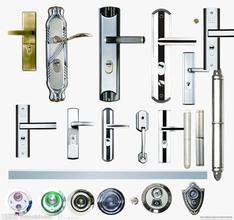Materials and Surface Treatment of Locks
When buying locks, people usually worry about they are not durable or it won't be long before the surface rust and oxidize. This problem is related to surface treatment and the selection of materials.
Materials
From the perspective of the durability, the best material should be stainless steel, especially when being used as the surface material, more with more light. It has very good strength, strong corrosion resistance, and its color remains the same. However, there is also a variety of stainless steel, and the main one can be divided into ferrite and austenite. Ferritic stainless steel is magnetic, which is commonly known as stainless iron, whose life span is long, and will also rust under a bad environment. Only the austenitic stainless steel does not rust, and the identification method is simple - use magnet.
Copper is one of the most widely used locks material. Its mechanical performance, corrosion resistance and processing performance are all good, and its color and lustre are gorgeous, especially the copper forging handle and other locks decoration. It also has smooth surface, good density, porosity, and sand holes. It is both solid and antirust and can be used to 24k gold plated or gold dust and other surface treatment, which can make them look gorgeous, noble and generous.
Zinc alloy material, its strength and anticorrosive ability is not so good, but its advantage is that it is easy to make design of complex parts, especially pressure casting. In the market the more complex pattern of lock is most likely made of zinc alloy, but consumers have to carefully identify.
Steel has better strength, lower cost, but is easy to rust, which is generally used as a lock structure materials used but unfavorable external decoration.
Aluminum or aluminum alloy, aluminum alloy (except aerospace use) is soft and light, its material strength is low, but easy to processing forming.
Surface treatment is refers to using metal electrodepositing (commonly known as electroplating), coating (painting), chemical oxidation (color) or other processing methods to cover or form a layer of protection membrane on the surface of parts. The membrane is mainly anti-corrosion effect, which also increases the beautiful appearance and the durability of the product and is an important factor of directly measure product quality. The commonly used methods to measure surface treatment are: measure cover layer with thickness, together with overall performance check, salt fog and humidity test, and appearance inspection, etc. Coating layer can select coating adhesion, hardness, moisture test, and visual inspection method, etc.





